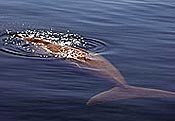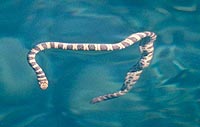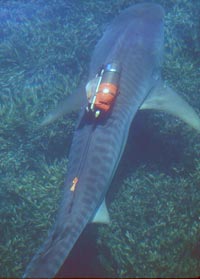
Research Projects – Diving Behavior


Dugongs can only be observed for a couple seconds every few minutes and we don't see every one that is on a transect.
Effects of Predation Risk on Diving Behavior


breathing allows a diving animal to spend
a greater amount of time underwater
looking for food but also puts them at
greater risk of shark attack. SBERP is
trying to determine if divers modify their
diving behavior to enhance their safety
margin when sharks are around.


prey at the surface are vulnerable from
tiger shark attack from below.
Many important predators in the oceans are air-breathers. Marine mammals (seals and sea lions, otters, whales and dolphins, sea cows, etc), sea turtles, sea birds, and sea snakes all forage underwater but must come to the surface periodically to breathe. The amount of time that they can spend underwater - which is determined by how long they spend at the surface each time they come up to breathe - determines how long they have to forage, how much energy they can gather over the course of a day, and their impacts on their prey. Not surprisingly, marine biologists have spent the last several decades trying to understand what influences how long divers spend at the surface and how long they spend underwater. These studies have focused on how efficiently a species can gather oxygen at the surface, the distribution of food resources, and many other factors. The possibility that predators might change how air-breathers dive, however, has been largely overlooked until recently. This probably is because most diving species have large body sizes and are considered top predators. But other than mammal-eating killer whales, almost all diving species are threatened by predators.
In Shark Bay, we have begun to investigate the effect of tiger shark predation risk, and other factors (e.g. habitat, water temperature, body size) on the diving behavior of dugongs and pied cormorants. Using mathematical models, we have generated predictions about how these tiger shark prey should change their diving behavior to balance the needs of gathering energy while diving and reducing the risk of being eaten by tiger sharks. These divers must balance risk and getting food because the longer a turtle or cormorant spends at the surface, the longer it can stay underwater to forage but it also is at greater risk since being at the surface is very dangerous with tiger sharks hunting from below. Because tiger shark abundance varies seasonally (click here for more information) and across habitats we can determine the responses of divers to multiple factors including predation risk. We have found that cormorants do change their diving behavior in response to the presence of sharks. They shorten their surface times (at the cost of shorter dives) in the most dangerous habitats (edges of banks) during periods of high shark abundance. Similarly, dugongs engaging in dangerous excavation foraging increase their surfacing rates when tiger sharks are abundant. This may be so they can move above the mud plume they have created to look for sharks.
Turtle diving behavior is assessed using time depth recorders (TDR) and animal-borne video and environmental data collection systems (AVEDs) (click here for more information on how we study turtles). So far we have deployed more than 150 TDRs and AVEDs on turtles. We are curently conducting analyses to investigate the possibility that turtles change their diving and swimming behavior in response to sharks.
Green turtles have much shorter surface times than loggerhead turtles year-round, which may contribute to their low incidence of shark injuries. Loggerhead turtles are less efficient at exchanging oxygen with each breath, so they are unable to have short surface intervals like green turtles. Check back later for the latest updates on our studies of diving under the risk of predation.
Developing Diving Correction Factors for Survey Data
Transect surveys, where observers drive or fly along a set line and count all the animals they see, are an important tool for assessing population sizes and determining patterns of habitat use. However, diving animals are difficult to survey because in many cases observers will not see all the animals on a transect because they are underwater. How many animals do surveyors miss? We need to be able to estimate this in order to know how large populations are or how many individuals are in a habitat. It isn't always easy to figure out how to correct counts because individuals may change their diving and surfacing patterns in different habitats or in different seasons. By studying how diving and surfacing patterns influence our ability to detect individuals of multiple species (sea snakes, dugongs, cormorants, sea turtles) across different habitats and seasons we will be able to make greater use of our transect data and help studies of diving species in other locations around the world.
Relevant Publications
- Thomson, J. A., M. R. Heithaus, and L. M. Dill. 2011. Informing the interpretation of dive profiles using animal-borne video: a marine turtle case study. Journal of Experimental Marine Biology and Ecology 410: 12-20.
- Thomson, J. A., D. A. Burkholder, A. B. Cooper, M. R. Heithaus, and L. M. Dill. 2012. Heterogeneous patterns of availability for detection during visual surveys: spatiotemporal variation in sea turtle dive-surfacing behaviour on a feeding ground. Methods in Ecology and Evolution 3: 378-387.
- Wirsing, A. J., M. R. Heithaus, and L. M. Dill. 2011. Predator-induced modifications to diving behavior very with foraging mode. Oikos 120: 1005-1012.
- Dunphy-Daly, M. M., M. R. Heithaus, A. J. Wirsing, J. S. F. Maradon, and D. A. Burkholder. 2010. Predation risk influences the diving behavior of a marine mesopredator. Open Ecology Journal 3: 8-15
- Heithaus, M. R. and A. Frid. 2003. Optimal diving under the risk of predation. Journal of Theoretical Biology 2233: 79-93.
- Heithaus, M. R., A. Frid, and L. M. Dill . 2002. Shark-inflicted injury frequencies, escape ability, and habitat use of green and loggerhead turtles. Marine Biology 140: 229-236.
- Heithaus, M. R. J. M. McLash, A. Frid, L. M. Dill, and G. J. Marshall. 2002. Novel insights into the behavior of sea turtles from animal-borne cameras. Journal of the Marine Biological Association UK: 1049-1050.
All photographs copyrighted; Images may be used for educational purposes. For use in other forms contact Mike Heithaus

